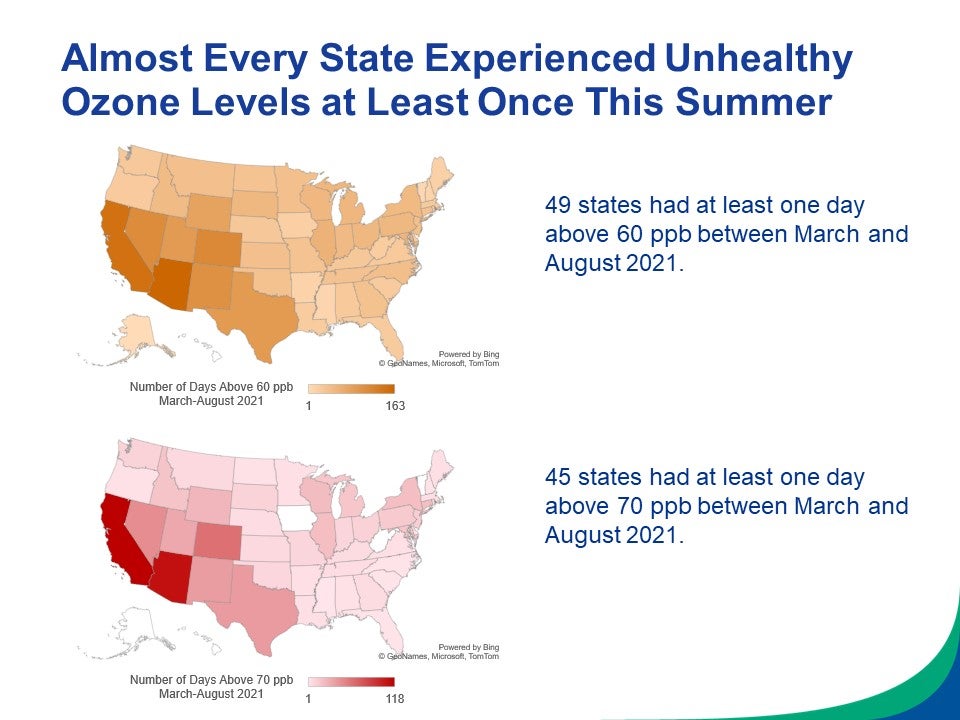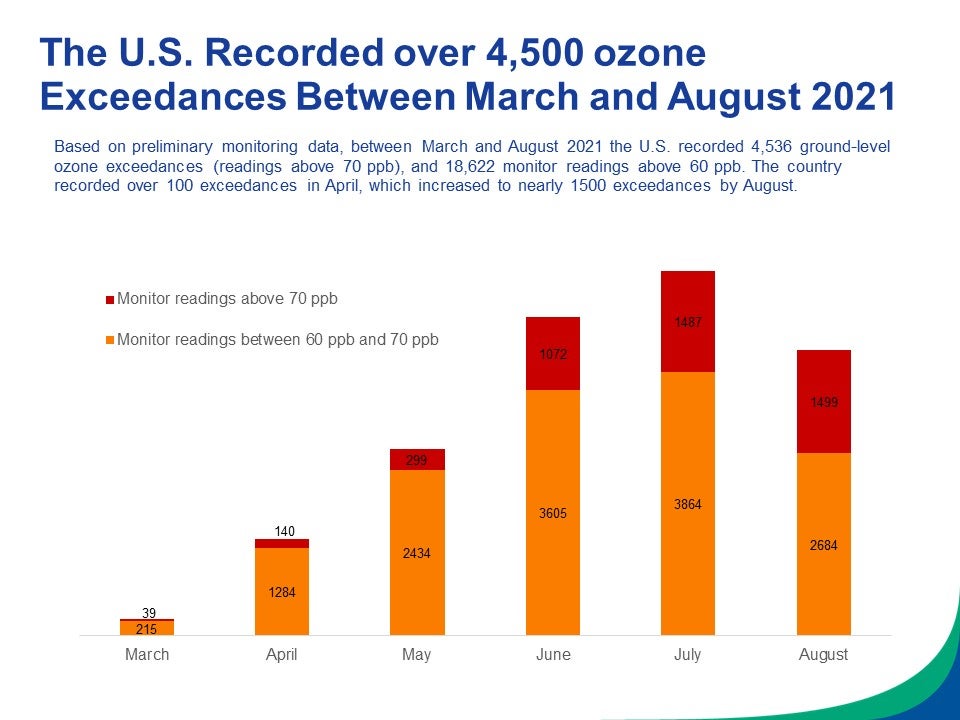In addition to checking the temperature and the chance of rain before leaving home, many people have been forced to add a new indicator to their daily weather check – air quality.
Ground-level ozone pollution – more commonly known as smog – reached dangerous levels across the U.S. this summer. EDF’s new analysis found that almost every state experienced unhealthy levels of it, with millions of Americans exposed to dangerous air pollution.
The current national standard for ground-level ozone pollution is 70 parts per billion. As you can see from the maps above, 45 states had at least one day between March and August with levels that exceeded that limit.
However, there is a substantial and growing body of scientific evidence that shows serious health effects from ground-level ozone exposure at levels below the current standard. When the data is expanded to consider ground-level ozone levels greater than 60 parts per billion, which would be a health-based standard more consistent with the scientific evidence, the picture of summer ozone levels is even more concerning – all but one state (Hawaii) had at least one day with levels that exceeded that amount.
Our analysis also found:
- The Western U.S. experienced the worst ozone levels in the country this summer. California, Arizona and Colorado experienced the most high-ozone days between March and August.
- 343 counties recorded at least one high-ozone day. San Bernardino, California recorded the most exceedances – 112 high-ozone days between March and August, including almost every day in July and August.
- More than 31 million people live in the 24 counties that had more than 20 high-ozone days between March and August, including Denver County in Colorado, Maricopa County in Arizona, and Los Angeles County in California.
- If you use the more health-protective standard of 60 parts per billion, a majority of days between March and April had unhealthy ozone levels across the Western U.S.
- In Arizona, under the 60 parts per billion standard, 89% of days between March and August had unhealthy ozone levels somewhere in the state.
There were many wildfires this summer and wildfire smoke is one of the sources that can contribute to elevated levels of ozone pollution. EPA establishes standards based on health science alone, and the agency has long had policies in place that allow states to account for truly exceptional events. Our analysis includes all recorded high ozone readings and does not exclude any high ozone days
Why ground-level ozone pollution is dangerous
Ground-level ozone forms through the interaction of heat, sunlight, and certain pollutants. These pollutants (volatile organic compounds, or VOCs, and nitrogen oxides, or NOx) mainly come from vehicles, power plants, industrial facilities, and oil and gas pollution.
Ground-level ozone pollution significantly increases the risk of serious heart and lung diseases and causes premature deaths. There is strong evidence of ground-level ozone pollution causing increased hospital admissions and emergency department visits for asthma and respiratory infections and possibly increasing rates of asthma development.
Ground-level ozone levels tend to be higher in the summer due to the increased heat and sunlight, and the 2021 ozone season was no exception. Our analysis shows that Americans across the country experienced unhealthy levels of ground-level ozone pollution, with air quality monitors registering more than 4,500 readings above 70 parts per billion between March and August.
EDF’s last analysis, in 2019, found air quality monitors registering many fewer smog exceedances — more than 2,500, compared to this year’s more than 4,500.
What’s even more concerning is this data is based only on existing air quality monitors used by EPA. Recent scientific research suggests that elevated levels of air pollution may not be fully captured by the existing monitoring network.
It’s not just our cities – it’s also our National Parks
The poor air quality due to ground-level ozone pollution spans beyond our metropolitan areas and impacts National Parks across the country as well. National Parks from Maine to California are experiencing their share of unhealthy ozone levels.
So far in 2021 there have been 250 ozone exceedance days in 24 National Parks and National Monuments across the country – almost 70% more than at this point last year. In Sequoia and Kings Canyon National Park in Northern California alone there were 68 high ozone days between April and August, with almost every day in July and August having dangerous ozone levels.
Our analysis also looks at exceedances in National Parks based on existing monitors. A recent report by the National Parks Conservation Association found many parks have outdated monitors, broken monitors, or no monitors at all, so these statistics likely fail to capture the full scope of the problem.
What we can do about it
The Environmental Protection Agency now has an opportunity to strengthen our national, health-based standards for ground-level ozone.
Despite the clear harms of ground-level ozone, the compounding effect of increasing temperatures driven by climate change, and the importance of protecting the health of millions of Americans, the prior administration ignored the science and maintained the existing ozone standard of 70 parts per billion. However, EPA is very soon expected to announce whether it will reconsider and strengthen this outdated ozone standard.
EPA is also developing standards that can substantially reduce ozone forming pollution, including forthcoming standards for the oil and natural gas sector and freight trucks and buses.
Also, advanced and innovative monitoring solutions can provide a fuller picture of air quality levels across the country. It is important for EPA to integrate these solutions in a manner that can strengthen and expand the existing network. That will help ensure vulnerable populations who are exposed to dangerous air pollution are protected by strengthened standards.
EDF’s analysis shows the importance of EPA strengthening our national air quality standard for ground-level ozone pollution consistent with the scientific evidence, in order to protect the health of millions of Americans across the country. A stronger, more protective standard will help ensure future summers have fewer days with harmful pollution levels.











